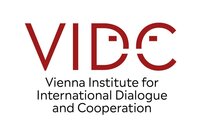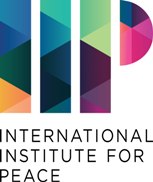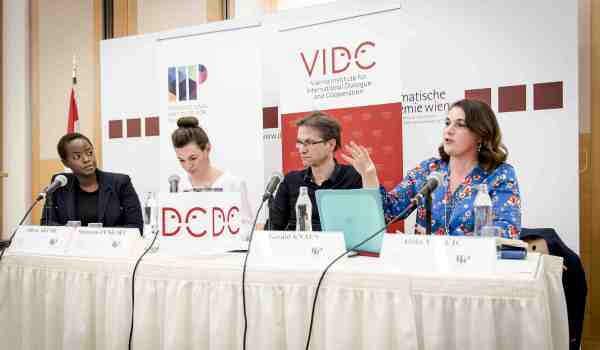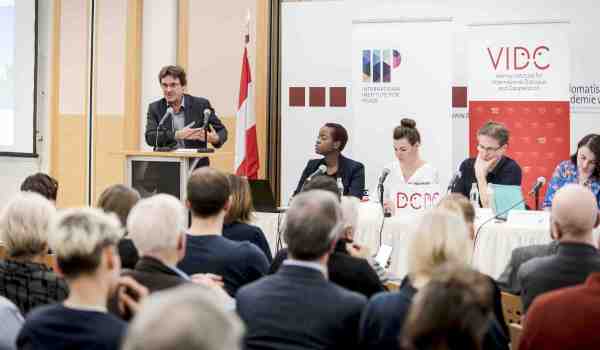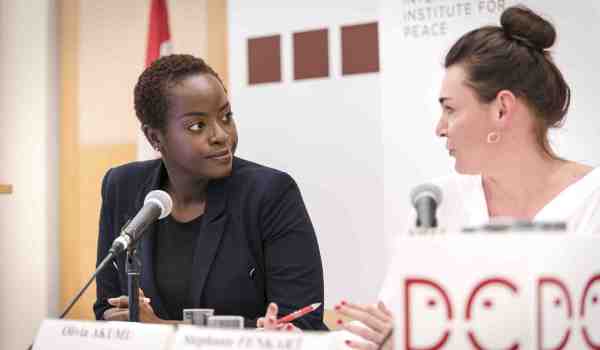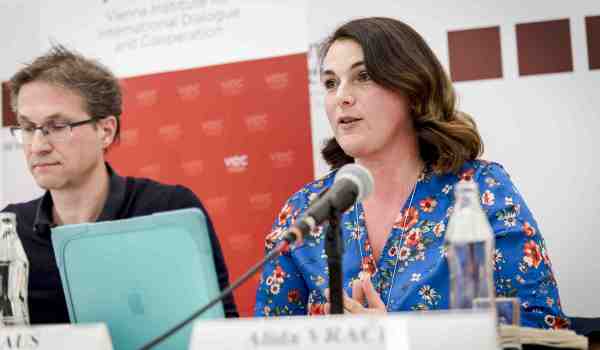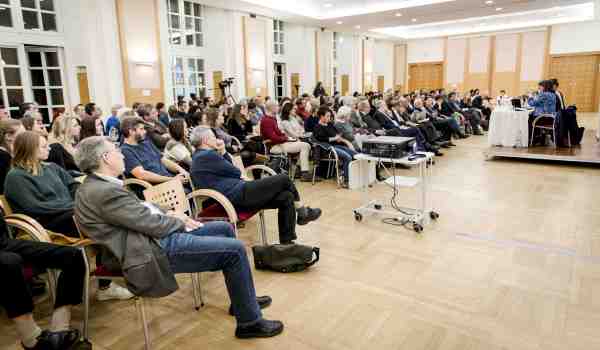(Nur in englischer Sprache verfügbar) On February 25th, the International Institute for Peace (IIP) and the Vienna Institute for International Dialogue and Cooperation (VIDC) hosted the event “Fortress Europe? Current Migration Trends and European Responses” at the Diplomatic Academy Vienna. The event focused on the changing dynamics of migration around Europe today – in particular the case studies of East Africa and the Western Balkans and EU policy
responses toward migration.
Vice Director of the VIDC Franz Schmidjell introduced the panel, citing the need for a new migration dialogue that is fair and respectful for all parties and incorporates countries of origin, countries of transit, and countries of destination. The panel was composed of Olivia Akumu, analyst at the Mixed Migration Centre (MMC) in Nairobi; Alida Vračić, director of the Populari think tank in Sarajevo, Europe Futures Fellow at the Institute for Human Sciences (IWM) and the Erste Foundation in Vienna; and Gerald Knaus, policy advisor and director of the European Stability Initiative (ESI) in Berlin.
The event was moderated by Director of the IIP Stephanie Fenkart, who underscored the obsessive focus on migration in policy discussions across EU since 2015 and emphasized the need to incorporate accurate facts and figures into any debate.
Most refugees stay in the region
Akumu, the first panelist, discussed the rising trend of “mixed migration,” which she defined as cross-border movements of people – including refugees, victims of trafficking, and economic migrants – who move for multiple reasons, have different legal statuses, and face a number of vulnerabilities. These individuals are frequently subject to human rights violations and tend to travel along similar routes with similar means of travel, often wholly or partially assisted by smugglers. The reasons for migration today, which often overlap, include conflict, endemic poverty, large youth populations, persecution, drought, urbanization, and mass deportation.
In East Africa today there are 4.5 million refugees and asylum-seekers and 5.2 million internally displaced people (IDPs). Majority of the refugees within the region are from South Sudan (2,1 mio) and DR Congo (670.000) while most transregional and transcontinental migrants come from Eritrea, Ethiopia, and Somalia. There are three primary routes for East African migrants: eastern (through Yemen to the Gulf states), southern (mostly to South Africa), and northern (through North Africa to Europe). By far the most significant route with approximately 11.000 migrants per month is to the east, and the percentage of migrants taking the northern route has dropped from 22% in 2016 to less than 1% in 2019. Akumu underscored in particular the humanitarian crisis in Libya, where East Africans compose over 90% of detention camps, which are often the site of human rights abuses and torture.
Distilling key trends in migration research in recent years, Akumu noted increased complexity (more drivers of migration, 71 % indicated more than one reason); increased mixing of reasons (regular, irregular, forced, economic); increased versatility (routes and methods); increased exploitation (by states and criminal groups); increased numbers of migrants; and decreasing toleration of migration (increased securitization). At present, states have very different perspectives on the benefits and costs of migration. Countries of origin seek to protect their citizens, boost remittances, and alleviate unemployment; countries of transit seek to boost their economies; and countries of destination seek to control migration flows. Moving forward, these countries will have to reconcile their different perspectives and aims while prioritizing the protection of migrants.
Policy of circular migation

Vračić spoke next, focusing on the role of migration in the Western Balkans, the challenge of emigration and brain drain, and the potential for programs to capitalize on circular migration. Emigration and brain drain are understood as key problems in the region and are widely discussed by citizens of the Western Balkan countries.
However, a key obstacle to understand these challenges is a lack of accurate data; a proper grasp of the size and scale of emigration would help demystify the impact of migration in the region and add nuance to the current debate, which is often greatly exaggerated by local media that focus on one-dimensional depictions of emigration without noting returns or circular migration.Different state and international agencies have sought to measure migration flows in the region, with
Eurostat citing around 230,000 emigrants from the Western Balkans in recent years; the total number of diaspora from Western Balkan is estimated 6 million, a considerable figure for the size of the region. Among key reasons for emigration, poverty, unemployment, and a lack of economic opportunities are often cited as the predominant drivers. However, Vračić added that pessimism, a feeling of hopeless, corruption, elite cronyism, and a lack of structural change are also important explanatory factors today. Young and talented individuals in particular do not see a future for themselves in the region and often opt for emigration to improve their life prospects. The emigration of trained professionals has had a particularly negative impact on sectors such as the health industry, as the region now has a lack of trained professionals. Young people in the Western Balkans often receive a high-quality and low-cost education in their home country and then emigrate to the EU given the strong financial incentives and employment opportunities in countries such as Germany.
Western Balkan governments have to-date done little to address this challenge and lack of coherent migration policies, although Serbia has sought to begin tracking migration. Circular migration in particular has not entered the policy discourse. Vračić argued that there is serious potential to take advantage of the sizable diaspora populations of each of the Western Balkan states through new, innovative mechanisms. Ireland provides a strong example for how to capitalize on diaspora communities by boosting investment in domestic industries, transferring knowledge and skills, expanding philanthropy, and changing the narrative around emigration to increase pride and connection among the diaspora.
Moreover, Vračić noted that it is time that Western Balkan countries themselves begin to attract immigrants, citing the high number of asylum applications in the region in recent years. However, immigration to the region will pose new challenges, as Western Balkan states will have to figure out how to integrate new populations into their labor markets. She concluded that emigration is indeed a significant challenge, but there is a need to change the narrative around migration in the region.
Dystopian and utopian views
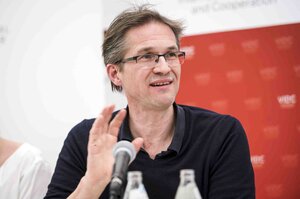
Lastly, Knaus emphasized the need to rely on accurate information to understand the dimensions of the current migration situation. He first outlined two competing visions for migration around the world today: a dystopian view and a utopian view.In the dystopian vision – exemplified today by leaders such as Hungary’s Viktor Orban – migration can threaten culture, livelihoods, language, sovereignty, and religious identity. Leaders such as Orban have sought to build alliances in order to promote their vision, meeting with politicians such as Marine Le Pen in France, Matteo Salvini in Italy, and Donald Trump in the US. These leaders emphasize the threat of new crises emerging, including the potential 800,000 new refugees from Syria’s Idlib province as well as the ongoing humanitarian crisis faced by 40,000 refugees in the Aegean Sea. In this vision, the Balkans serve as the battlefield for migration to the EU, and thus there is a need to harden borders and build walls.
Conversely, the utopian vision promotes the idea of “open borders,” whereby borders between states should no longer exist. Proponents of this concept argue that open borders would eliminate poverty worldwide, as borders today serve as the most severe form of birth discrimination and perpetuate a system of “global apartheid.”
Opting for a more nuanced vision, Knaus cited the need for a reality check for both sides. First, the scale of migration is often much smaller than envisioned or portrayed by politicians and the media. For example, in 2017, Schengen visas were granted to 2.2 million Africans; 1.6 million of these went to citizens of just three countries (Algeria, Morocco, and Tunisia). The number of visas issued for countries such as Nigeria has actually decreased from 2010 to 2018. At the same time, irregular migration from Africa to Europe has in fact been exceptionally low in recent years in comparison to historical rates, with the exception of 2014-2017. For comparison, the number of migrants from Africa to Italy in 1999 was 49,999; in 2018, it was 23,371.
To address the continued irregular migration from Africa to Europe, which leads to human rights abuses in transit, deaths at sea, and limited opportunities upon arrival, Knaus explained a new “Gambia plan,” which would seek to replace irregular migration with regular migration and has been discussed with political decision makers in The Gambia and Germany. The plan consists of three key steps: regularize migrants currently in Germany who have not been sentenced for crimes; send back anyone who arrives after a specified date; and offer concrete legal mobility options on the ground(by opening consulates, offering scholarships or legal work mobility, etc.). These solutions can be reached on the local level and also require the involvement of civil society – for example by promoting the voices of migrants who experienced abuse on irregular migration routes.
Turning toward the Western Balkans, Knaus discussed the ideas of a “Swiss borders” option, whereby citizens would be able to
travel freely between states. This would help overcome divisions among groups in the region and promote communication and exchange. Making internal borders invisible, as the EU’s Schengen border project was able to achieve, could help spur growth and reconciliation.
The event concluded with questions from the audience, which touched on the role of human trafficking in migration; Austrian policy toward migration; comparisons between East Africa and West Africa; the role of corruption; and the impact of leadership. Vračić concluded that migration cannot be stopped, and thus it should be regulated in order to benefit all countries and individuals involved.
The Gambia Plan

To address the continued irregular migration from Africa to Europe, which leads to human rights abuses in transit, deaths at sea, and limited opportunities upon arrival, Knaus explained a new “Gambia plan,” which would seek to replace irregular migration with regular migration and has been discussed with political decision makers in The Gambia and Germany. The plan consists of three key steps: regularize migrants currently in Germany who have not been sentenced for crimes; send back anyone who arrives after a specified date; and offer concrete legal mobility options on the ground(by opening consulates, offering scholarships or legal work mobility, etc.). These solutions can be reached on the local level and also require the involvement of civil society – for example by promoting the voices of migrants who experienced abuse on irregular migration routes.
Turning toward the Western Balkans, Knaus discussed the ideas of a “Swiss borders” option, whereby citizens would be able to
travel freely between states. This would help overcome divisions among groups in the region and promote communication and exchange. Making internal borders invisible, as the EU’s Schengen border project was able to achieve, could help spur growth and reconciliation.
The event concluded with questions from the audience, which touched on the role of human trafficking in migration; Austrian policy toward migration; comparisons between East Africa and West Africa; the role of corruption; and the impact of leadership. Vračić concluded that migration cannot be stopped, and thus it should be regulated in order to benefit all countries and individuals involved.
